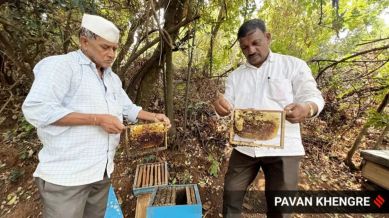With the pricing system of mobile cab hailing services like Uber and Ola under a scanner, here is what goes into algorithmic pricing
Cab aggregators Ola and Uber have been handed a government notice over concerns of differential pricing on their apps depending on the device the customer is using. (Express Photo)
With India’s consumer protection agency sending notices to cab aggregators Ola and Uber pertaining to the alleged difference in the fares they show on Android and Apple devices, there is a renewed spotlight on algorithmic pricing that most tech companies with a marketplace model deploy.
“As a follow-
up to the earlier observation of apparent #DifferentialPricing based on the different models of mobiles (#iPhones/ #
Android) being used, Department of Consumer Affairs through the CCPA, has
issued notices to major cab aggregators #Ola and #Uber, seeking their responses,” Union Minister of Consumer Affairs, Pralhad Joshi said in a post on X Thursday.
In recent months, several user complaints about the discrepancy in pricing on Android and
iOS devices have cropped up on social media. Existing research and experts suggest, however, that these applications are considering multiple factors, beyond just hardware.
Advertisement
“We do not set prices based on a rider’s phone manufacturer. We look forward to working with the CCPA to clear up any misunderstanding,” an Uber spokesperson said in response to queries sent by
The Indian Express. Ola had not responded at the time of publication.
User complaints in India
For a few months now, several users on the Internet have shared screenshots showing a discrepancy between Uber/Ola fares on Android and
Apple devices. These screenshots showed that for the same distance and location, and at the same time of booking, fares on Apple devices were generally higher than on Android phones.
Some media reports also conducted basic searches on some of these apps to support this thesis.
The assumed logic here is that since Apple devices are typically more expensive than Android phones, people with Apple devices are likely to pay more than those with Android phones — something that the algorithms deployed by Uber and Ola take into account in their dynamic pricing models.
Notably, most marketplace-based companies like Uber and Ola use dynamic pricing for their fares. This means that fares are constantly changing, even on the same device, depending on the time of booking, real-time and traffic conditions, among other things.
While there is plenty of anecdotal evidence to suggest that prices are higher on iPhones than on Android devices, testing done by The Indian Express has shown that there is no way to reliably prove whether this is a sustained trend, as the Internet claims — we also found several instances where the opposite was true.
There has to be more than that going on under the hood.
Algorithmic pricing
And that brings one to a more fundamental question: what all parameters are actually weighed by companies before they determine algorithmic pricing?
The reality is, a clear picture of what is actually happening behind the scenes can only be ascertained after looking at the source code of the two applications, a technologist, who has previously worked for an online ride hailing company, said on condition of anonymity.
“Not just hardware, but several other factors: age, location, tracking across apps, browsing history, whether one uses a credit card to pay, etc. — all these can be used to determine pricing. But it is not a one-size fits all approach. The algorithms that are deployed are making these decisions for each person uniquely,” the technologist said.
Some studies offer additional clues.
In the US, for instance, the Federal Trade Commission (FTC) issued notices to companies last July, which it said offered “surveillance pricing” products, and services that incorporate data about consumers’ characteristics and behavior.
Earlier this year, interim findings of a market study carried out by the FTC revealed that details like a person’s precise location or browser history can be frequently used to target individual consumers with different prices for the same goods and services.
The FTC said that consumer behaviour ranging from mouse movements on a webpage to the type of products that consumers leave unpurchased in an online shopping cart can be tracked and used by retailers to tailor consumer pricing.
But there are indications that these apps could be relying on various other parameters, beyond just hardware or software identifiers.
For instance, a study released by researchers at the George Washington University in Washington
DC in 2020 found that ride-hailing companies charge a higher price per mile for a trip if the pick-up point or destination was a neighbourhood with a higher proportion of ethnic minority residents than for those with predominantly white residents. Companies like Uber and Lyft denied these findings at the time.


